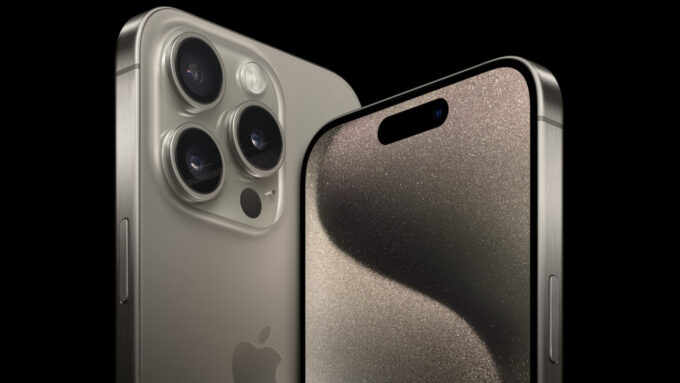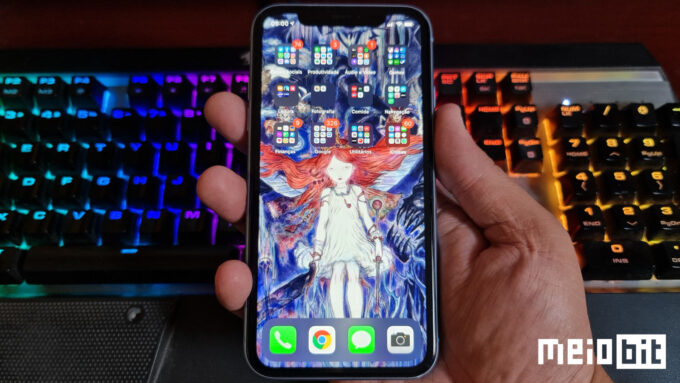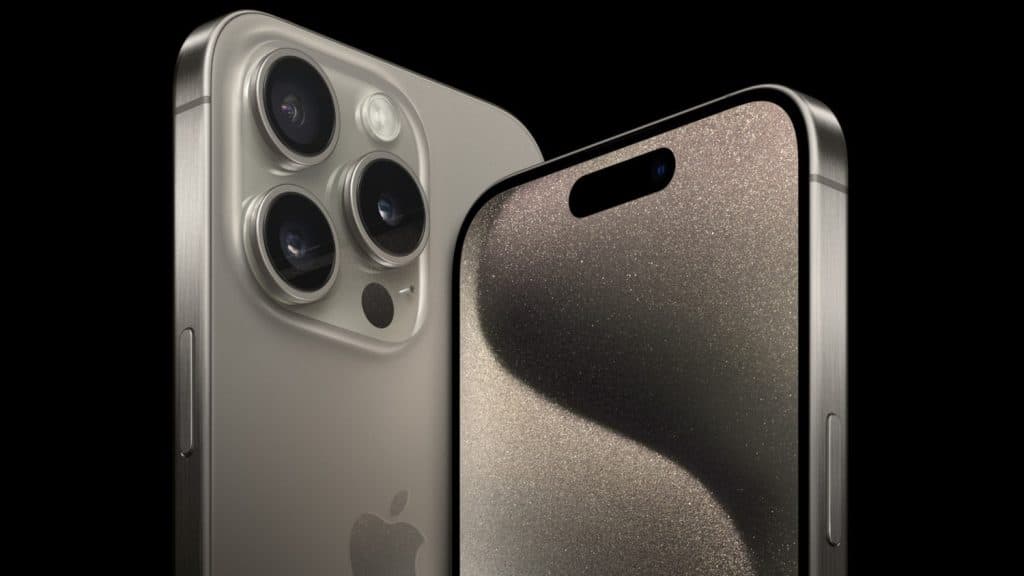Last Tuesday (12), the Apple presented the line iPhone 15, which bring “new features” such as a USB-C connector (3.0 only for the Pro and Pro Max; the others, which will come with USB 2.0 in 2023), better cameras, a GPU that promises to run AAA games with PS5 quality and Xbox Series X… but that's not what we're going to talk about here. It is a known fact that apple and Samsung have been living “between slaps and kisses” since 2010, when the South Korean company launched the first Galaxy S, which triggered a long legal battle between the parties, with one accusing the other of copying its designs in its products. The problem, Samsung was a supplier of several iPhone components, with an emphasis on “was”.
 The new iPhones, like the 15 Pro and 15 Pro Max above, will feature Samsung screens (Credit: Disclosure/Apple) Cupertino understood that it made no sense to keep a rival and enemy on the payroll, and over time, was removing Samsung from the list of mobile component suppliers. The most felt loss was the SoC, in which the Taiwanese TSMC guaranteed exclusivity by printing better processors. Of course, today it is known that Cupertino absolutely did not want Samsung to have access to the schematics of the Apple Silicon line of chips, for fear that their schematics could favor improvements in Exynos chips, but this does not apply to parts such as memory NAND flash storage, in which Sammy was replaced by SanDisk in the global market; in China, the current partner is CK Storage. The only component that Apple cannot eliminate Samsung's presence is precisely the most obvious in any self-respecting smartphone, the screen. All new models are equipped with OLED displays, and Koreans in general are great at developing products with organic dot technology, so it is not surprising that the second main supplier of screens for the iPhone is LG, its eternal rival. For a long time, Apple also manufactured smartphones, and although this is no longer the case, Apple ideally would not like to have companies with which it directly competes (or used to compete) in its list of suppliers. This was one of the reasons that led the giant to close with a third supplier of OLED displays, the Chinese BOE Technology, which already manufactured LCD screens for the iPad and MacBook lines. In January 2020, Apple positioned BOE as the number two supplier, ahead of LG, shortly before LG Mobile closed. This was done with the intention of placing the Chinese, who were responsible for the Huawei P30 Pro's display, at the top of the chain, to gradually reduce Samsung's participation, until removing it completely from the equation, and finally, from the list of iPhone component suppliers. Of course, there are some problems with implementing this plan. First and foremost, Samsung is just too good at what it does, in that the company meets all the specifications required by Apple, and delivers exactly everything that is required of it; the second, directly linked to the first, refers to the other companies, even LG, not coming close to the pace and quality of the main supplier. In 2022, BOE was caught altering the film film's internal circuitry design, increasing its width to simplify production, without notifying Apple, which suspended screen purchases for the iPhone 13 and 14 lines for a time; it was excluded from the supply chain, but was later reinstated.
The new iPhones, like the 15 Pro and 15 Pro Max above, will feature Samsung screens (Credit: Disclosure/Apple) Cupertino understood that it made no sense to keep a rival and enemy on the payroll, and over time, was removing Samsung from the list of mobile component suppliers. The most felt loss was the SoC, in which the Taiwanese TSMC guaranteed exclusivity by printing better processors. Of course, today it is known that Cupertino absolutely did not want Samsung to have access to the schematics of the Apple Silicon line of chips, for fear that their schematics could favor improvements in Exynos chips, but this does not apply to parts such as memory NAND flash storage, in which Sammy was replaced by SanDisk in the global market; in China, the current partner is CK Storage. The only component that Apple cannot eliminate Samsung's presence is precisely the most obvious in any self-respecting smartphone, the screen. All new models are equipped with OLED displays, and Koreans in general are great at developing products with organic dot technology, so it is not surprising that the second main supplier of screens for the iPhone is LG, its eternal rival. For a long time, Apple also manufactured smartphones, and although this is no longer the case, Apple ideally would not like to have companies with which it directly competes (or used to compete) in its list of suppliers. This was one of the reasons that led the giant to close with a third supplier of OLED displays, the Chinese BOE Technology, which already manufactured LCD screens for the iPad and MacBook lines. In January 2020, Apple positioned BOE as the number two supplier, ahead of LG, shortly before LG Mobile closed. This was done with the intention of placing the Chinese, who were responsible for the Huawei P30 Pro's display, at the top of the chain, to gradually reduce Samsung's participation, until removing it completely from the equation, and finally, from the list of iPhone component suppliers. Of course, there are some problems with implementing this plan. First and foremost, Samsung is just too good at what it does, in that the company meets all the specifications required by Apple, and delivers exactly everything that is required of it; the second, directly linked to the first, refers to the other companies, even LG, not coming close to the pace and quality of the main supplier. In 2022, BOE was caught altering the film film's internal circuitry design, increasing its width to simplify production, without notifying Apple, which suspended screen purchases for the iPhone 13 and 14 lines for a time; it was excluded from the supply chain, but was later reinstated.
 iPhone XR (Credit: Ronaldo Gogoni/Meio Bit) Apple had plans for BOE to take the lead in screen supply, starting with the iPhone 16 line in 2024, while it would increase its share for the iPhone 15 now, allowing Samsung was gradually depreciated, until it was removed from the equation; LG could run it too, but the idea would be to keep it as a backup. Of course, Reality spoke stronger. BOE was unable to maintain the pace that Apple wanted, which meant not changing the designs, which LG and Samsung follow and are able to produce, and had problems with light leakage in the Dynamic Island, the cutout to accommodate the sensors and selfie camera . As a result, the number of Chinese orders was reduced, and these were transferred to Samsung. However, LG also got complicated. The company was appointed to produce the OLED displays for the iPhone 15 Pro and Pro Max lines, the top of the line, as the quality of their screens are, in general, better than Samsung's (and also due to the disaffection), but Although the display division was able to meet the specifications, it was unable to meet the certification deadline for the Pro Max. LG Display received approval to deliver the iPhone 15 Pro screens, but the stamp that allows it to sell the components of the more expensive model it will only come this month, and until then, rival Samsung will be responsible for production, which initially ensured dominance in supply for the iPhone 15 line, albeit thanks to the incompetence of other suppliers. And the supply will continue without delays, at least when it comes to the display. Samsung owes this to the fact that it was for a long time the only manufacturer of iPhone screens, and thus, it has experience and a production line ready to fill holes in other supplier companies, to ensure its stay on the list of suppliers, but there is also the Usage Experience™️ factor that Apple does not give up. For the apple, final quality always comes first, even if it means continuing to do business with a “partner” that it barely tolerates; Meanwhile, Samsung counts the money and is grateful, in a troubled relationship that should last for a few more years. Source: Korea IT News
iPhone XR (Credit: Ronaldo Gogoni/Meio Bit) Apple had plans for BOE to take the lead in screen supply, starting with the iPhone 16 line in 2024, while it would increase its share for the iPhone 15 now, allowing Samsung was gradually depreciated, until it was removed from the equation; LG could run it too, but the idea would be to keep it as a backup. Of course, Reality spoke stronger. BOE was unable to maintain the pace that Apple wanted, which meant not changing the designs, which LG and Samsung follow and are able to produce, and had problems with light leakage in the Dynamic Island, the cutout to accommodate the sensors and selfie camera . As a result, the number of Chinese orders was reduced, and these were transferred to Samsung. However, LG also got complicated. The company was appointed to produce the OLED displays for the iPhone 15 Pro and Pro Max lines, the top of the line, as the quality of their screens are, in general, better than Samsung's (and also due to the disaffection), but Although the display division was able to meet the specifications, it was unable to meet the certification deadline for the Pro Max. LG Display received approval to deliver the iPhone 15 Pro screens, but the stamp that allows it to sell the components of the more expensive model it will only come this month, and until then, rival Samsung will be responsible for production, which initially ensured dominance in supply for the iPhone 15 line, albeit thanks to the incompetence of other suppliers. And the supply will continue without delays, at least when it comes to the display. Samsung owes this to the fact that it was for a long time the only manufacturer of iPhone screens, and thus, it has experience and a production line ready to fill holes in other supplier companies, to ensure its stay on the list of suppliers, but there is also the Usage Experience™️ factor that Apple does not give up. For the apple, final quality always comes first, even if it means continuing to do business with a “partner” that it barely tolerates; Meanwhile, Samsung counts the money and is grateful, in a troubled relationship that should last for a few more years. Source: Korea IT News
